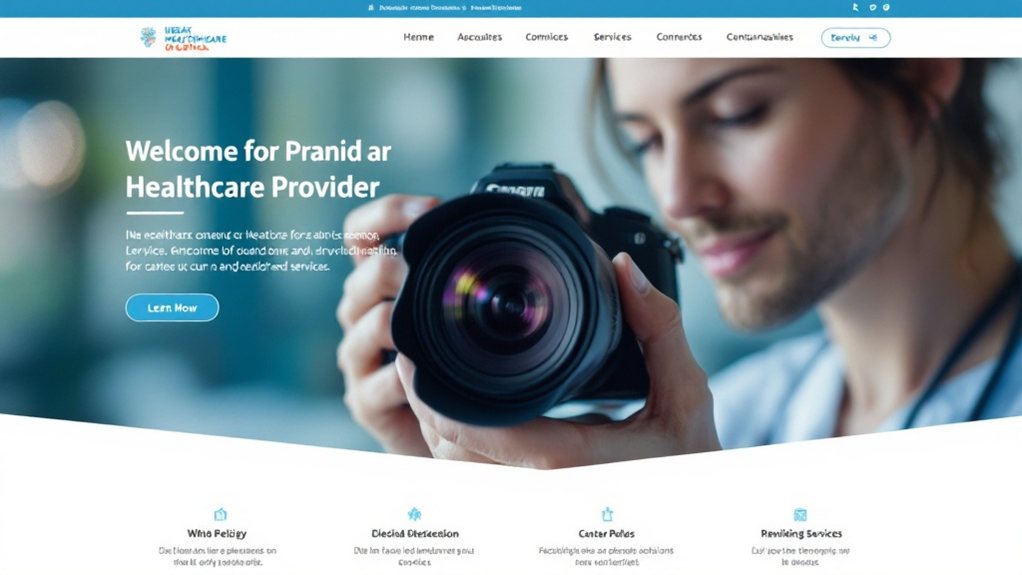Prioritize a clear, hierarchical menu structure and intuitive search. Optimize for mobile by prioritizing speed and mobile-specific features. Incorporate interactive tools like symptom checkers and virtual visits to boost engagement. Ensure consistent branding and professional visuals. Use plain language, short paragraphs, and accessible design for readability. Leverage data insights to continuously improve. By implementing these tips, you'll create an intuitive healthcare website that engages patients and encourages deeper exploration.
Key Takeaways
- Prioritize clear and intuitive navigation with a hierarchical menu structure, straightforward labels, and mobile-responsive design.
- Optimize for a mobile-friendly experience by utilizing responsive techniques, prioritizing fast load times, and leveraging mobile-specific features.
- Incorporate interactive features and tools like symptom checkers, appointment schedulers, and live chat to foster deeper engagement.
- Ensure consistent branding and visual design with a coherent color palette, typography, and high-quality imagery.
- Focus on content accessibility and readability by using plain language, logical organization, and accommodating users with disabilities.
Prioritize Clear and Intuitive Navigation

When designing a healthcare provider website, prioritizing clear and intuitive navigation should be at the forefront. Patients should be able to easily find the information they need, whether it's scheduling an appointment, accessing medical records, or learning about services. Use a clean, hierarchical menu structure and labels that are straightforward and user-friendly. Implement intuitive search functionality and ensure the website is mobile-responsive, as many patients will access it on the go. Additionally, consider including a sitemap or breadcrumb navigation to help users orient themselves within the site. By focusing on simplicity and usability, you'll create a healthcare website that patients find helpful and empowering.
Optimize for Mobile-Friendly Experience
With the growing trend of mobile device usage, optimizing your healthcare provider website for a mobile-friendly experience is crucial. Ensure your site's layout, navigation, and content are easily accessible and readable on smaller screens. Utilize responsive design techniques to create a seamless experience across devices. Prioritize quick page load times, as mobile users expect immediate access to information. Optimize images and media to minimize data usage and improve load times. Simplify navigation, making it intuitive for users to find what they need. Leverage mobile-specific features like click-to-call buttons and GPS integration to enhance the user experience. By delivering a mobile-optimized website, you'll meet the needs of your on-the-go patients and improve overall engagement.
Incorporate Interactive Features and Tools

Incorporating interactive features and tools can elevate your healthcare provider website, fostering deeper engagement with your patients. Consider integrating tools like symptom checkers, appointment schedulers, and secure patient portals. These allow patients to actively participate in their care, ultimately leading to better health outcomes. Leverage interactive video content for medication tutorials or wellness tips. Incorporate live chat or messaging functions, so patients can connect with your staff in real-time. Gamified elements, like progress trackers or reward programs, can motivate patients to adopt healthier behaviors. By thoughtfully weaving these interactive elements throughout your site, you'll create a compelling and user-friendly experience that sets your practice apart.
Ensure Consistent Branding and Visual Design
Consistent branding and visual design are essential for your healthcare provider website. Use a consistent color palette, typography, and imagery across all pages to create a cohesive brand identity. Ensure your logo is prominently displayed and aligns with your offline branding. Utilize high-quality, professional-looking images that convey the essence of your practice. Avoid cluttered layouts and distracting design elements. Keep the navigation intuitive and easy to use. Implement responsive design to ensure a seamless experience across devices. Regularly review and update your website to maintain a modern, fresh appearance. Consistent branding builds trust and credibility, making it easier for patients to recognize and engage with your healthcare services.
Focus on Content Accessibility and Readability

Beyond consistent branding, your healthcare website's content must be accessible and easy to read. Use clear, plain language that your target audience can understand. Avoid industry jargon and complex terminology. Break up text into short, scannable paragraphs with descriptive subheadings. Ensure your content is well-structured and logically organized. Employ bullet points, numbered lists, and visual elements to highlight key information. Make your website accessible to users with disabilities by providing alt-text for images and ensuring your site is compatible with screen readers. By prioritizing content accessibility and readability, you'll engage patients more effectively and improve their overall experience.
Leverage Data-Driven Insights for Continuous Improvement
Your healthcare website's performance should be continuously monitored and refined based on data-driven insights. Leverage website analytics to track user behavior, identify pain points, and optimize the user experience. Analyze visitor flow, bounce rates, and time spent on pages to uncover areas needing improvement. A/B test layout, content, and calls-to-action to determine what resonates best with your audience. Gather feedback through user surveys and online reviews to further enhance the website. By adopting a data-driven approach, you can make informed decisions that continually improve the intuitive design and overall effectiveness of your healthcare provider website.
Foster Patient Engagement and Communication

A well-designed healthcare provider website should foster patient engagement and communication. Encourage patients to interact with your site by incorporating features like online appointment booking, secure messaging, and educational resources. Ensure your website's content is easy to understand and speaks directly to patients' needs and concerns. Leverage multimedia, such as videos and infographics, to convey information more effectively. Optimize the user experience by keeping navigation intuitive and enabling patients to find what they're looking for quickly. Regularly solicit feedback from patients and use their insights to continuously refine your website. By prioritizing engagement and communication, you'll build trust and strengthen the patient-provider relationship.

